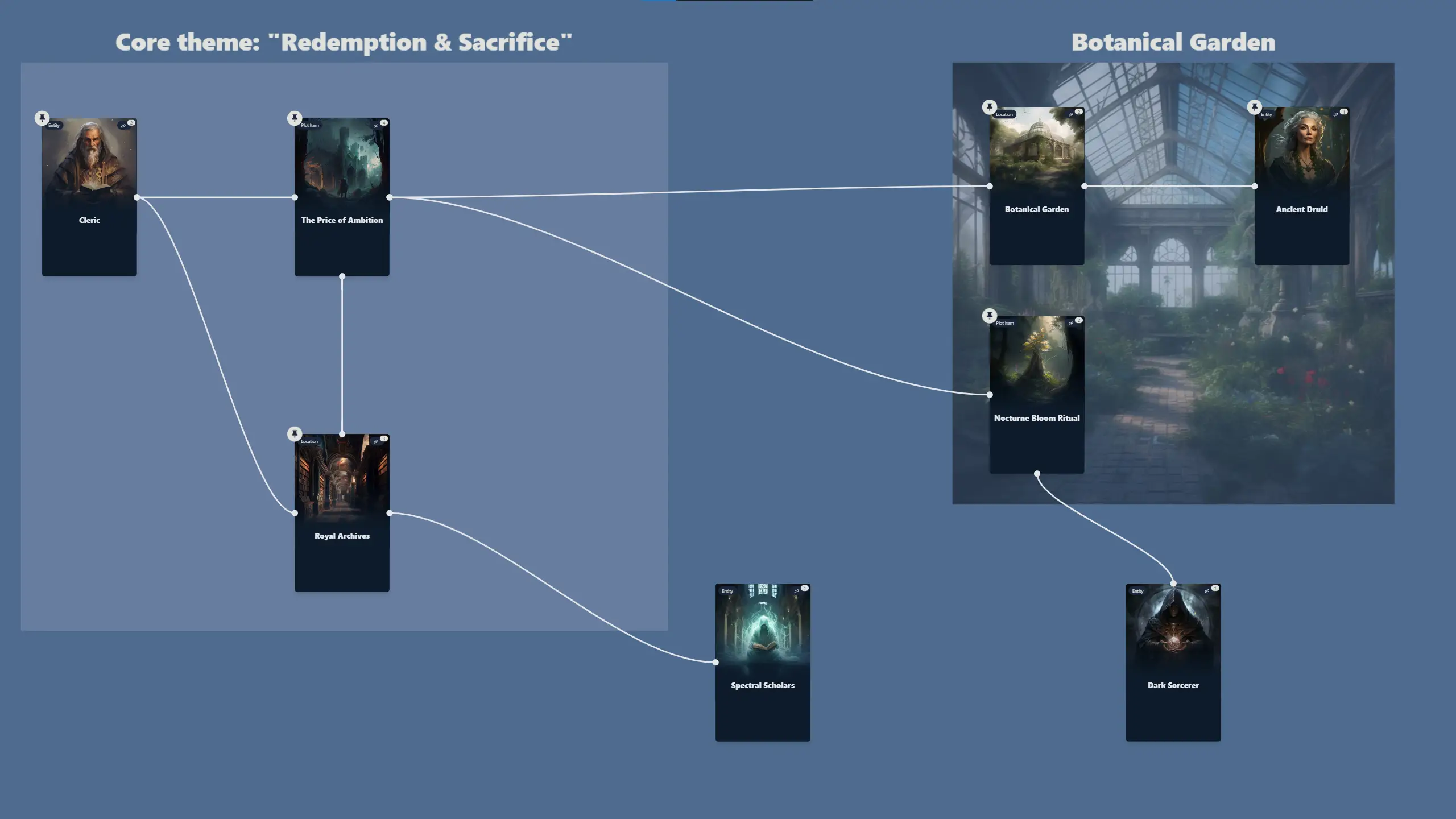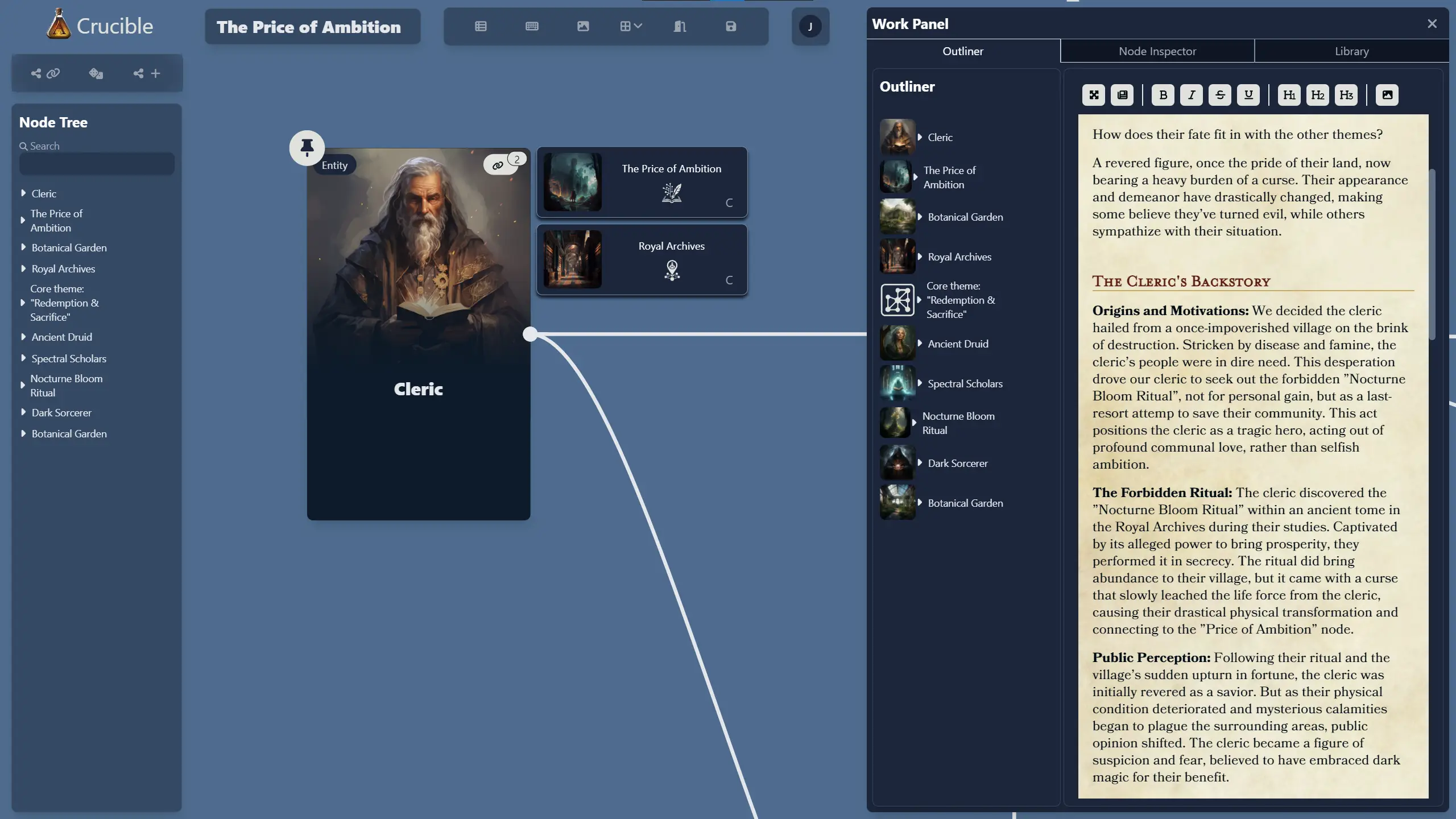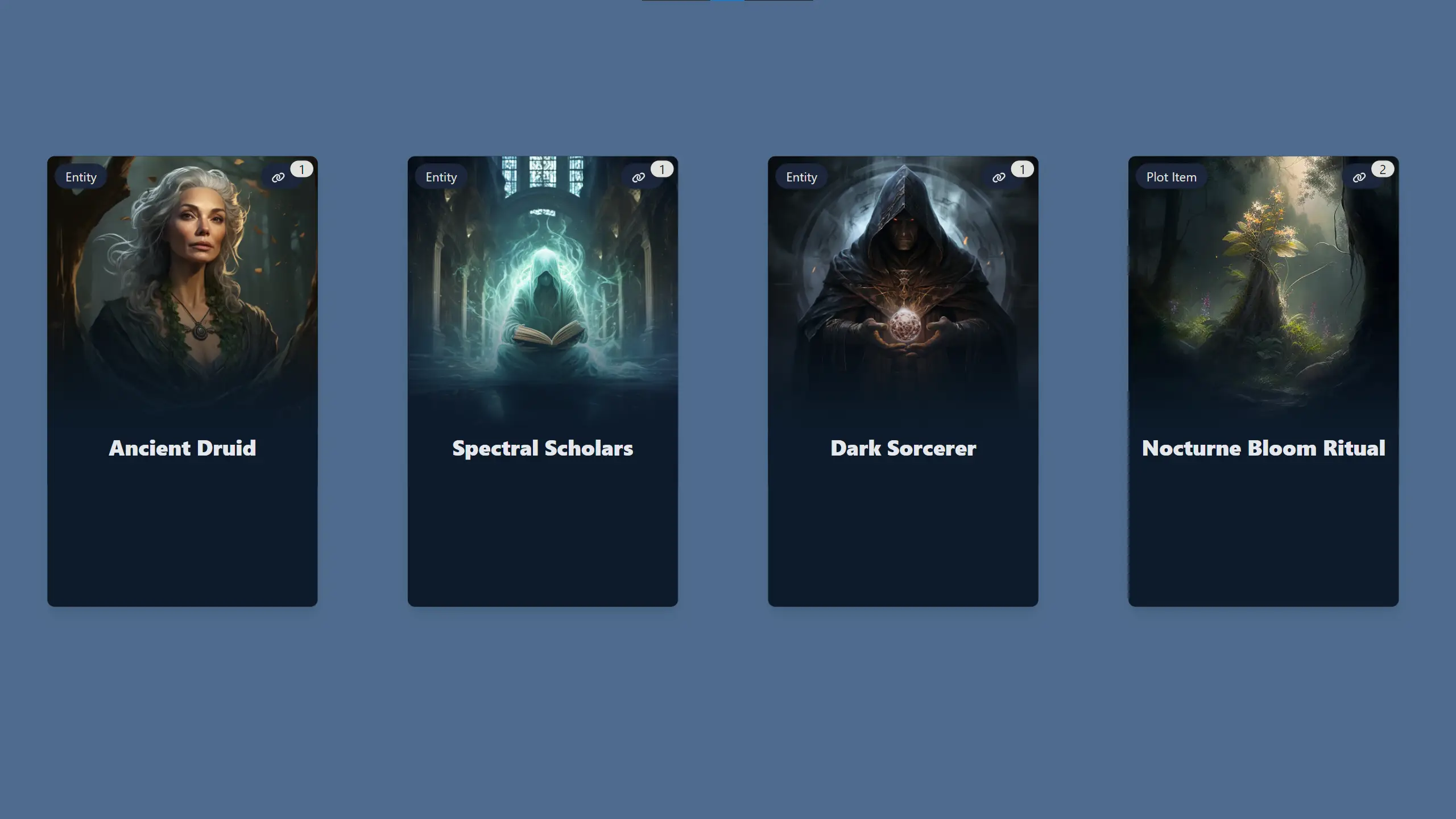
The development of Crucible, our new node-based module writing application, is making good progress. Enough so that we're able to share with you some initial test runs.
In this installment, we're diving into the second phase of a module braistorming using Crucible as visual support and writing tool.
As you may have seen in the first part of this series, we decided to start with a creative constraint: a set of four nodes, randomly drawn by Alkemion’s Deck:
“The Price of Ambition” (a Plot node), “Botanical Garden” (a Location node), “Royal Archives” (another Location node) and “Cleric” (an Entity node).
This step is focusing on deepening our plot, introducing sub-plots, and adding new nodes to enrich our story!
Our narrative's pivotal figure necessitates a solid backstory with motive, conflict, and depth. Here we expanded on the cleric's past, answering critical questions to add layers to their persona and to the story:

Origins and Motivations: We decided the cleric hailed from a once-impoverished village on the brink of destruction. Stricken by disease and famine, the cleric's people were in dire need. This desperation drove our cleric to seek out the forbidden "Nocturne Bloom Ritual," not for personal gain, but as a last-resort attempt to save their community. This act positions the cleric as a tragic hero, acting out of profound communal love, rather than selfish ambition.
The Forbidden Ritual: The cleric discovered the "Nocturne Bloom Ritual" within an ancient tome in the Royal Archives during their studies. Captivated by its alleged power to bring prosperity, they performed it in secrecy. The ritual did bring abundance to their village, but it came with a curse that slowly leached the life force from the cleric, causing their drastic physical transformation and connecting to the "Price of Ambition" node.
Public Perception: Following the ritual and the village's sudden upturn in fortune, the cleric was initially revered as a savior. But as their physical condition deteriorated and mysterious calamities began to plague the surrounding areas, public opinion shifted. The cleric became a figure of suspicion and fear, believed to have embraced dark magic for their benefit.
The Quest for Redemption: Tormented by the unintended consequences of their action and the physical toll it exacted, the cleric returned to the archives, seeking a way to reverse the curse. Their frequent, frantic searches caught the attention of both the Spectral Scholars and the Dark Sorcerer, setting the stage for the PCs' involvement.
The cleric's detailed past shows them as a good-hearted hero who made tough choices and now wants to make things right. This makes the story more interesting and highlights the module’s ideas about sacrifice, redemption, and dealing with the results of our choices. It also helps players feel closer to the cleric, pulling them deeper into the story.
As we brainstormed, we saw the need for more nodes to enrich our story and add variety to our module. These new nodes are essential for our sub-plots and the possibilities in our original nodes. Here's how we developed and included each one:

"Ancient Druid" (Entity): Realizing the significance of the Botanical Garden in our tale, it became apparent that this location needed a guardian, a figure deeply intertwined with its history and secrets. The Ancient Druid emerged as this guardian, possessing extensive knowledge about the Nocturne Bloom and a profound understanding of its implications. This character is intended to challenge the party’s motives and potentially set tasks or obstacles to test their worthiness.
"Spectral Scholars" (Entity): The Royal Archives, a place of hidden and forbidden knowledge, whispered to us tales of those so devoted to their scholarly pursuits that not even death could sever their connection. Thus, the Spectral Scholars were conceived as entities trapped between planes, adding a layer of mystery and challenge to acquiring the archive's secrets. Their inclusion not only creates an eerie atmosphere but also presents an opportunity for social interaction and puzzle-solving within the module.
"Dark Sorcerer" (Entity): Every story benefits from tension and a sense of urgency, and ours was no different. To introduce a competing force against the players, we envisioned the Dark Sorcerer, a figure shrouded in malevolence, also seeking the Nocturne Bloom but for selfish gain. This character heightens the stakes, bringing in the classic race against evil and adding a potential adversary for the players to confront.
"Nocturne Bloom Ritual" (Plot Item): To fully flesh out the significance of the Nocturne Bloom, we decided it needed a dedicated plot item node. The "Nocturne Bloom Ritual" represents a forbidden rite capable of extraordinary magical feats, directly tying into the cleric's past actions and the present predicament. This plot item serves as a central pivot around which major decisions and plot developments will revolve.
After introducing new elements into our story, the next move was to weave these nodes into our existing narrative framework effectively. This required us to establish clear, logical links that would enrich and drive the plot.
Linking two nodes goes beyond just saying they're related. Each connection is a chance to dig deeper into our story. We need to explain and really think about why these points are connected. What's the story behind this link? What new adventures could come from it? By asking these questions and fleshing out the details, we're not just drawing lines—we're building a richer, more exciting story.

Here's how we connected our new nodes in Crucible:
"Botanical Garden" -> "Ancient Druid": Our narrative suggests the Ancient Druid as an integral part of the Botanical Garden. He's not just a simple resident; he is its guardian and, in many ways, the essence of the garden itself. This connection implies that players will have to interact with the druid to gain any meaningful access or information related to the garden. Will they have to prove themselves worthy, negotiate, or resort to trickery? The nature of this interaction can set the tone for their entire experience within the garden.
"Royal Archives" -> "Spectral Scholars": The Spectral Scholars, trapped within the Royal Archives, are a goldmine of plot potential. By linking these nodes, we conceptualize the archives not just as a place of dusty tomes and forgotten lore, but as a realm where the past actively dwells. These spirits could be gatekeepers of the knowledge the PCs seek, adding layers of challenge. Are they friends, foes, or something in between? Their existence turns the archives into a dynamic environment, ripe with potential encounters.
"Dark Sorcerer" -> "Nocturne Bloom Ritual": This connection is vital as it introduces urgency and conflict to the plot. The Dark Sorcerer is after the same powerful ritual that our PCs will likely seek, setting the stage for a classic race against time. However, the sorcerer's intention is malevolent, contrasting with what might be the PCs' noble cause, and highlighting the potential danger of the Nocturne Bloom Ritual.
"The Price of Ambition" <-> "Nocturne Bloom Ritual": Here, we connect the initial motive with the potential solution or downfall. The cleric has faced the consequences of "The Price of Ambition" by initially performing the "Nocturne Bloom Ritual."
Each of these connections serves not just to enhance the individual nodes, but to reinforce the narrative structure, creating a world that's interconnected and responsive to the players' choices. Crucible’s interface makes these links clear and manageable, allowing us to keep track of complex narrative elements with ease.
As we progress, it's vital to revisit our nodes, adding texture and depth to the narrative elements. Each character and plot point must resonate, offering layers that can be peeled back session after session.

Here's how we enriched our story:
"Ancient Druid": More than a mere guardian of the garden, the druid now has a past connection with the cleric. Were they friends? Colleagues? Or perhaps they shared a mentor-student relationship? This bond adds emotional weight to their potential encounter, packing a punch for player engagement.
"Spectral Scholars": Initially just lost souls, these entities now gain complexity. What if one of them mentored the cleric in the past? This connection could serve as a poignant subplot, wherein the cleric's actions led to the mentor's current state, further emphasizing the theme of ambition's consequences.
"Dark Sorcerer": Instead of a straightforward villain, what if the sorcerer's ambitions are personally tied to the cleric's past? This relationship, perhaps a fallout or rivalry, complicates the PCs' decisions—they're not just facing an evil entity but entangling with the cleric's history.
Each refinement aims to deepen the emotional and moral stakes, encouraging players to invest not just in the action, but in the narrative's soul.
The Cleric's redemption arc remains our narrative's beating heart. However, by introducing these sub-plots and additional characters, we've created a world that's alive and teeming with possibilities. Players are now part of a rich tapestry where their choices hold weight and can lead to diverse outcomes.
What began as a simple set of random nodes looks now more like a detailed module, with its own history, mysteries, and imminent dangers. Each node, carefully crafted and interconnected, now pulses with life, ready to challenge and engage players in the story.
This iterative process of brainstorming, connecting, and refining, facilitated by the application, is a very fun and efficient process. Stay with us as we journey into the next steps. We will look into pathways, challenges, and to how the world reacts to the players' decisions.